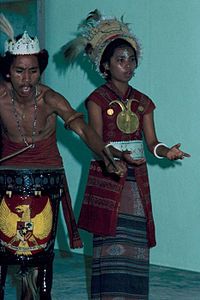Moluccans

Southeastern Maluku traditional ceremony.
|
|
| Total population | |
|---|---|
| (approx 3,900,000) | |
| Regions with significant populations | |
|
Indonesia (Maluku, Maluku Islands, West Papua) The Netherlands Australia Germany Canada United Kingdom United States Austria |
|
| Languages | |
| Native languages of the Central–Eastern Malayo-Polynesian languages group such as the Dawera-Daweloor language and Taliabo language; also Indonesian (official purpose/as medium of communication to non-Moluccan Indonesians/home or instructional medium language especially for the younger generations), while those living in the diaspora speak; English, German and Dutch | |
| Religion | |
| Protestantism (Moluccan Evangelical Church, Protestant Church of Maluku), Islam, Roman Catholicism, Hinduism. | |
| Related ethnic groups | |
| Melanesians, Papuan people |
Moluccans refer to the original, indigenous inhabitants of the Maluku Islands, also called the Moluccas, which have been part of Indonesia since 1950. Moluccans are a blanket term for many ethnic and linguistic groups inhabiting the island groups.
Moluccans were originally Melanesian in origin. However, a long history of trade and seafaring has resulted in a high degree of mixed blood ancestry among Moluccans.Austronesian peoples added to the native Melanesian population around 2000 BCE. Melanesian features are strongest in the islands of Kei and Aru and amongst the interior people of Seram and Buru islands.
Later added to this Austronesian-Melanesian mix were Dutch, Chinese, Portuguese, Spanish and English genes due to colonization and marriage with foreign traders in the Middle Ages or with European soldiers during World War. Small number of German descendants added to Moluccan population especially in Ambon along with arrival of Protestant Missionaries since 15th century.
A small population of Moluccans (~45000) live in the Netherlands. This group mainly consists of the descendants of KNIL soldiers who had originally planned to come the Netherlands only temporarily, but were eventually forced to stay. (See Moluccan diaspora.) The remainder consists of Moluccans serving in the Dutch navy and their descendants, as well as some who came to the Netherlands from western New Guinea after it was handed over to Indonesia. However, the vast majority of Moluccans still live in the Moluccas and the other surrounding region such as Papua, West Timor, North Sulawesi, Bali and Java.
...
Wikipedia
